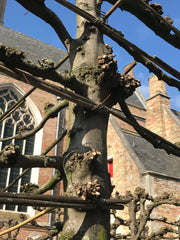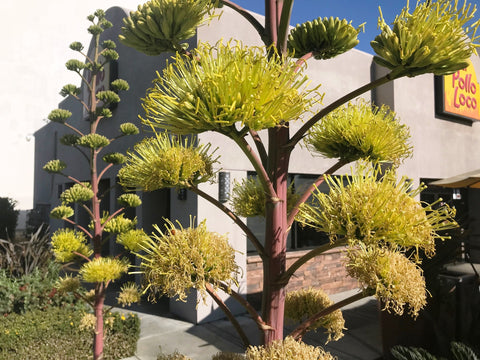


















Booker T Washington once said "Success in life is founded upon attention to the small things rather than to the large things; to the every day things nearest to us rather than to the things that are remote and uncommon."

On a day to day basis I couldn't agree more with Mr. Washington. But on some recent hikes, on opposite ends of this great nation, I found happiness in "large", "remote", and "uncommon".

Muir Woods, federally protected as a National Monument since 1908, might not be home to the "record holders" when it comes to California's Redwoods (Sequoia sempervirens), but this old growth forest is more than reachable with a short drive from anywhere in San Francisco. There's no cell service in or around the forest, so even though your close to civilization, you are immediately put into a solitary state of mind.

It rains a lot here, especially in winter. Rainfall averages are around 50" a year, but on this winter day the trail was dry and the company was good.


Any gardener worth his or her salt will tell you a plant is only as good as the soil it stands in. At the feet of these giants is a dark brown, humus-rich loam. A mix of gravel, stone, and sand help aerate those large roots and drain away some of that winter water.

Redwoods can grow to nearly 400' tall, but most in Muir are around 250' The trees in the park are between 500 and 800 years old. The oldest is at least 1,200 years old!
One final argument against Booker T's proclamation that "success in life is founded upon attention to the small things rather than to the large things". Did you know that the tallest tree ever measured was a Eucalyptus? In 1872 forester William Ferguson found a E. regnans in Victoria, Austrailia that measured 435' tall!

Folks are always sending me pictures, good and bad, of their Eucalyptus. I love to see progress and hear stories of success, but I also value the opportunity to solve problems and learn from their experiences.
Enter Joe Seamone, a life long gardener and consultant at a Maryland Landscape Mamagement Co. Joe's been experimenting with Hardy Eucalyptus, palms and bananas for the past 20 years. Joe ordered a 4" 'Mappa Tassie' and 'Grace' from Southern Eucs, followed proper planting and watering practices, and sent me these pictures of the trees back on June 8 (10 weeks ago).


Then Joe sent me this email with the attached pictures of the same trees just 10 weeks later.
"My two eucs I ordered from you are doing great … they are both about 5 feet high (from 8" in June). I tipped them and they are busting out."


I know Eucs are fast growers, but this is pretty impressive stuff. I contacted Joe for more information. He responded with the below email:
"For years, I have used fish emulsion on all new plants, shrubs trees, tropicals, palms etc.

I've found a weekly commitment to fish emulsion + miracle gro in the hose end sprayer and watering in the warm season did this every time.…


Joe also attached a before and after photo, same regimen, of the last 18 months showing his tree growth especially with loblolly pines. The top photo was taken March 2017, bottom photo Aug 31, 2018. Wow!


The west coast, all the way up the Pacific Coast Highway, from San Diego to San Francisco, is where I first gained an appreciation for Eucalyptus trees. I was utterly amazed at what a solitary Euc could do to soften and frame a home’s otherwise desert landscape.

Or completely change the character and offer much needed shade to an entire neighborhood.
Now some Californians have recently turned their backs on Eucs. After planting them for hundreds of years (when/where nothing else would grow) as windbreaks for farms and orchards, for aesthetics, and for timber, they now say it’s time for their invited and gracious guests to go.
Proponents of the “native only” movement” like to co-mingle the “invasive” and “non-native” tags to win their argument against the trees. But not all non-natives are invasive!
The non-native tag is true. Eucs are native to Australia and belong to the Myrtaceae family. Yes, just like our beloved Crepe Myrtles.
But keep an open mind when casting off non-natives. They bring much needed species diversity, offer animal shelter, nectar, and sometimes provide a better choice (see dogwoods and elms) than natives in the landscape. And remember, corn, strawberries, avocadoes, chickens, cows, and most of us, are not natives either! I think that claim goes only to the American Indian and fish!!!
Alright, enough with all the politics. The real reason for this blog is to share some pictures and surprises from a recent west coast trip and visit to the wonderful world of Disney.

The Anaheim, CA park welcomes over 70,000 visitors a day. I think it was closer to 100,000 when we arrived. Disney’s horticulturists and designers are some of the best in the world. They could choose any plant to welcome their high paying patrons through the gate. But they choose Eucalyptus!

It is a great way to stop and smell the Eucs before paying the piper and mixing with the masses. Also, Eucs as a canopy, is counterintuitive to the argument that they are prone to dropping their limbs. Can’t see the Disney lawyers missing on that one!

The tree lined street was functional in both providing filtered shade and screening the massive parking lots. And the use of Eucs as specimens was prominent at the park’s famous photo-op.

From a gardener’s perspective there was also enough “Disneyfied” stuff to appreciate, and still ask why?

Never got the animal topiary thing! Still, it was good to see - when some in California have turned their back on Eucs – that Disney still has an appreciation for the diverse trees.


On a recent shopping trip from my home in McDonough, GA to the Krog Street Market in Atlanta, I got an idea to see just how many thriving Eucalyptus trees, hopefully Southern Eucs, I could locate on the 30 mile northbound drive. Mile marker one was easy. Sitting in my driveway, 16 years after planting, I’m still in awe of the 35’ tall, original ‘Angus’.
(Thought) I lost one of the ‘Angus’ Eucs to a 6 degree winter back in 2015, but now have a nice 15’ replacement that has regrown from the base.
Twenty feet down the driveway are a 30’ tall, three-year old ‘Cab Sav’, and 20’ tall, 16 yr. old ‘Funky Monkey’,
I know, my own house, kinda like cherry pickin’. Let’s hit the road! Just a mile away there’s a Southern Eucs success story at Matt and Mary Jane Portwood’s house.. They needed to replace a dead Wax Myrtle in a high profile area they use for entertaining. They planted this 1 gallon neglecta ‘Big 0’ about 18 months ago and are thrilled with the rapid growth, fragrance, and light shade it provides.
This stunning Euc 2 miles away is in the historic section of McDonough and it fits perfect with this home's color and craftsman style.
Mile marker four is a Euc that I have long kept tabs on. This (unidentifiable) 40’ tall Eucalyptus tree calls the Ola area of Henry County home. I’m confident it is a Southern Eucs because of its proximity to the nursery I used to own and sell Eucalyptus trees from.

At mile marker five, right near the entrance of I75, are three, I think, rubida ‘Cab Savs’.They do a great job screening the interstate and filtering the sounds of the busy interstate.
Just off the exit is a trials participant in East Atlanta. Scott Lootens, a videographer by trade, always sends great pictures documenting the rapid growth of his three-year-old ‘Big 0’ and pauciflora ‘Bonza’.
Working my way over to the Market, I have fist hand knowledge of a great Southern Euc in the Emory Area. I helped plant it at world renowned designer, metal fabricator and TV host Bryan Fuller's cottage style house in the Emory area of Atl.
Finally, Krog Street Market and mile thirty of the shopping spree, turned Southern Eucs sighting trip.
I know a lot of landscapers in the metro Atlanta have been adding Southern Eucs to their designs. And wouldn’t you know it, while looking for parking at the Market, I noticed that great silver-blue color - only a few trees can claim - highlighting this in town home’s tidy landscape.
Looks like a ‘Maggie’ but I didn’t want to intrude any further on the homeowner’s privacy. Absolutely love the placement as a specimen tree and how it sets apart this home from other’s in the Atlanta neighborhood.






And was quick to see positive results.

Heading into his second winter, he has seen some some impressive results with some specific varieties.

Shino's early reports stated he planted in an unprotected and uncultivated field with lots of grubs. "It was a very wet winter" Shino said, "with the lowest temperature twice recorded at -2 Fahrenheit. Still, three varieties showed substantial cold hardiness and have quickly regrown from the bases."
Eucalyptus neglecta 'Big O'
Eucalyptus pauciflora 'Bonza'
Eucalyptus parvula 'Funky Monkey'
Shino will be planting three new trees from our ongoing Southern Eucs trials. E. perriniana, a striking Spinning Gum with reported extreme cold hardiness. Eucalyptus palverulenta a small tree or shrub sought after for its foliage for use in arrangements. And Eucalyptus Macarthurii, or Camden Wollybutt, a large "oak-like" tree that grows in the broad cold flats in its native habitat..
Check out our next blog on "Atlanta's (Southern) Eucs!"

Here's a quick history of the yard since we bought our house last year:
We had 22 Pine Trees, 2 Laurel Oaks and 2 Red Maples removed about this time last year. The Pines were just too tall, and had to go. The others were diseased unfortunately... I hated to see them go. But hey, it made room for all these Eucs.

Here's a picture taken around November of last year when I was re-grading the yard (Yard is approximately 8500 sq.ft.)

So far I've planted Southern Eucs in the backyard only. I'm considering some for the front. We'll see. Here are some iPhone photos of the three I've gotten from Southern Eucs so far at planting: Here's Big O in the back left corner of my backyard:

https://southerneucs.com/products/eucalyptus-neglecta-big-o-eucalyptus-tree
Lucky Country at planting:

https://southerneucs.com/products/eucalyptus-camphora-lucky-country-eucalyptus-tree
Lucky Country has amazed me. Despite the root-ball and root-collar damage from shipment, it has taken off -- growing about 1 ft so far. It started showing growth within a couple days after planting. I'd have to say it is my favorite.

Note that the soil where Big O and LC are planted is at the lower grade of my backyard, and therefore gets quite mucky when we get heavy rains. We had a big storm just after planting Big O where we got 5 inches within a couple hours! The rain water took a few hours to drain down. Didn't seem to phase Big O. Funky Monkey at planting.

https://southerneucs.com/products/eucalyptus-parvula-funky-monkey-eucalyptus-tree
Grace showed slight stress initially after planting, but soon recovered strongly and is now showing new growth which appears to be picking up speed. This is despite my pug "marking his territory", and insects eating her leaves a bit, which I was surprised to see. I ended up planting her near our back-porch.

https://southerneucs.com/products/eucalyptus-elliptica-grace-eucalyptus-tree
And here is a photo taken about a month ago from the same angle as the first pict.:

Beautiful (Euc) yard Brian!!! look for our next blog post on "Atlanta Homes Utilizing Eucs!"